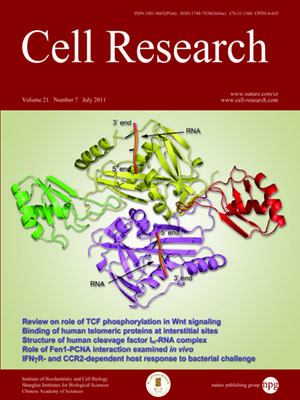Volume 21 Issue 7, July 2011: 1039-1051
ORIGINAL ARTICLES
Structural basis of pre-mRNA recognition by the human cleavage factor Im complex
Heng Li1,2, Shuilong Tong1,2, Xu Li1,2, Hui Shi1,2, Zheng Ying1, Yongxiang Gao1,2, Honghua Ge1,2, Liwen Niu1,2 and Maikun Teng1,2
1Hefei National Laboratory for Physical Sciences at Microscale and School of Life Sciences, University of Science and Technology of China, Hefei, Anhui 230026, China
2Key Laboratory of Structural Biology, Chinese Academy of Sciences, Hefei 230026, China
Correspondence: Maikun Teng, Liwen Niu,(mkteng@ustc.edu.cn; lwniu@ustc.edu.cn)
The cleavage factor I
m (CF I
m), consists of a 25 kDa subunit (CF I
m25) and one of three larger subunits (CF I
m59, CF I
m68, CF I
m72), and is an essential protein complex for pre-mRNA 3′-end cleavage and polyadenylation. It recognizes the upstream sequence of the poly(A) site in a sequence-dependent manner. Here we report the crystal structure of human CF I
m, comprising CF I
m25 and the RNA recognition motif domain of CF I
m68 (CF I
m68RRM), and the crystal structure of the CF I
m-RNA complex. These structures show that two CF I
m68RRM molecules bind to the CF I
m25 dimer via a novel RRM-protein interaction mode forming a heterotetramer. The RNA-bound structure shows that two UGUAA RNA sequences, with anti-parallel orientation, bind to one CF I
m25-CF I
m68RRM heterotetramer, providing structural basis for the mechanism by which CF I
m binds two UGUAA elements within one molecule of pre-mRNA simultaneously. Point mutation and kinetic analyses demonstrate that CF I
m68RRM can bind the immediately flanking upstream region of the UGUAA element, and CF I
m68RRM binding significantly increases the RNA-binding affinity of the complex, suggesting that CF I
m68 makes an essential contribution to pre-mRNA binding.
Cell Research (2011) 21:1039-1051. doi:10.1038/cr.2011.67; published online 12 April 2011
FULL TEXT | PDF
Browse 2461


